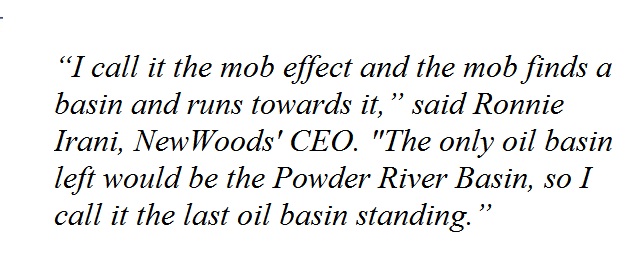
DALLAS—The last oil basin standing? It’s Wyoming’s Powder River Basin—and it’s where newly minted spin off NewWoods Petroleum LLC plans to make a stand of its own.
NewWoods is the surviving entity following the $2.75 billion sale of its 92,000-acres and 22,000 barrels of oil equivalent per day (boe/d) Delaware Basin position to WPX Energy Inc. (WPX) in August 2015. The original entity, RKI Exploration and Production LLC, retained its Converse County, Wyo. properties and rolled them into NewWoods Petroleum LLC.
Think of it as a new lease on corporate life—if the new lease refers specifically to NewWoods’ 340,000 net contiguous acres and 100% operated 10,000 boe/d in production in the Powder River Basin.
Following the stock, cash, and debt assumption sale to WPX, RKI’s management decided to re-position in the Powder River as NewWoods Petroleum LLC, a basin in which Ronnie Irani, NewWoods’ CEO, had been active since 1970. Irani prefers to stick with what he knows, which provides a case study in how smaller privately-held independents can run with the publicly held big dogs in the unconventional market.
“I’ve always been a strong proponent of staying in areas that you understand, staying in areas where you have experience, and building a core position,” Irani told attendees at Hart Energy’s A&D Strategies and Opportunities Conference. “Once you have amassed a core position it just becomes—I call it the black hole effect where you just start taking other stuff in and build a position over time. That’s certainly what happened to us in the Delaware Basin and in the Powder River Basin.”
The privately held independent is focusing on four stacked development plays in the Powder River: the Frontier, Niobrara, Parkman and Teapot formations. The acreage also has potential production in the deeper Belle Fourche, Mowry and Dakota formations.
“There are nine potential zones in the basin,” Irani said. “All of them have been proved through vertical drilling over the last 40 to 50 years. That’s what I like about it, and that’s why I’ve always been transfixed, really, with the Powder River Basin.”
Since 2012, NewWoods has coaxed production out of 59 horizontal Teapot wells, 51 horizontal Parkman wells, 20 horizontal Niobrara wells, and eight horizontal Frontier wells. In terms of stacked pay, NewWoods’ Wyoming proved acreage represents 750,000 surface-equivalent acres if spread out horizontally.
NewWoods is the third largest operator in the Powder River in a bifurcated market that has three top tier operators who hold between 340,000 to 360,000 acres and secondary holdings spread among four other operators who have Powder River positions below 220,000 acres.
From a standing start in 2012, NewWoods now touts proved reserves of 24.6 MMboe as of mid-June 2015, roughly 75% oil. The company ran five rigs in 2014 but dropped to one rig after oil prices collapsed with plans to grow to three active rigs in 2016. Since acreage is held by production, NewWoods has the ability to grow organically without the need for acquisitions or a rush to get locations drilled.
The shallower Powder River formations have respectable resumes when it comes to initial potential (IP). Normalized production averages 800 barrels per day (bbl/d) in the Teapot with Parkman production at 650 bbl/d. RKI, NewWoods’ predecessor, specifically targeted the Parkman, which features a normalized type curve estimated ultimate recovery (EUR) of 560,000 boe. Parkman wells provide an 18% rate of return currently, although hedging at NYMEX prices can generate returns up to 30%. In the Frontier, IPs fall just below 1,000 boe/d although total well count is lower, while EUR is pegged at 900,000 boe.
At the end of the day, Irani likes NewWoods’ new home on the Wyoming range where the company was an early mover in the Powder River.
“I call it the mob effect and the mob finds a basin and runs towards it,” Irani told conference attendees in Dallas. “First it was the Midland Basin, and then the mob found the Delaware Basin, and I think the mob finished the Delaware and looked around and said: what's left? And the only oil basin left would be the Powder River Basin, so I call it the last oil basin standing.”
Contact the author, Richard Mason, at rmason@hartenergy.com.
Recommended Reading
TG Natural Resources Wins Chevron’s Haynesville Assets for $525MM
2025-04-01 - Marketed by Chevron Corp. for more than a year, the 71,000-contiguous-net-undeveloped-acreage sold to TG Natural Resources is valued by the supermajor at $1.2 billion at current Henry Hub futures.
Summit Acquires Moonrise Midstream Assets to Alleviate D-J Constraints
2025-03-10 - A Summit Midstream Corp. (SMC) subsidiary will acquire Moonrise Midstream from Fundare Resources Co. in a cash-and-stock deal valued at $90 million.
Voyager Midstream Closes on Panola Pipeline Interest Deal
2025-03-19 - Pearl Energy Investments portfolio company Voyager Midstream Holdings has closed on its deal with Phillips 66 for its non-op interest in the Panola Pipeline.
Japan’s Mitsui Testing Western Haynesville Alongside Comstock, Aethon
2025-03-26 - Japanese firm Mitsui has plans to drill a horizontal well in the emerging western Haynesville play as renewed foreign investment in U.S. shale continues to pick up steam.
Vitol Boosts Upstream Presence in West Africa with $1.65B Deal
2025-03-19 - Vitol is acquiring oil and gas E&P assets in Cote d’Ivoire and the Republic of Congo from Eni for $1.65 billion.
Comments
Add new comment
This conversation is moderated according to Hart Energy community rules. Please read the rules before joining the discussion. If you’re experiencing any technical problems, please contact our customer care team.






